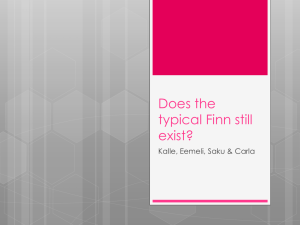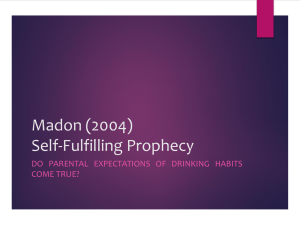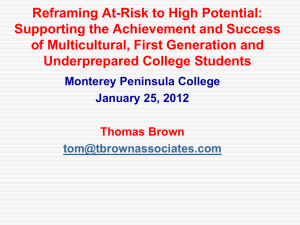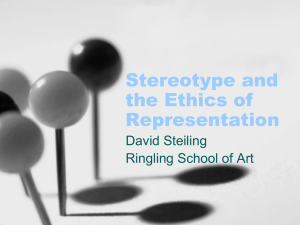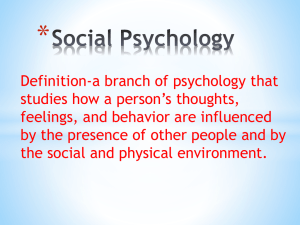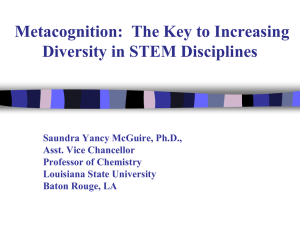StereotypesPart2student
advertisement
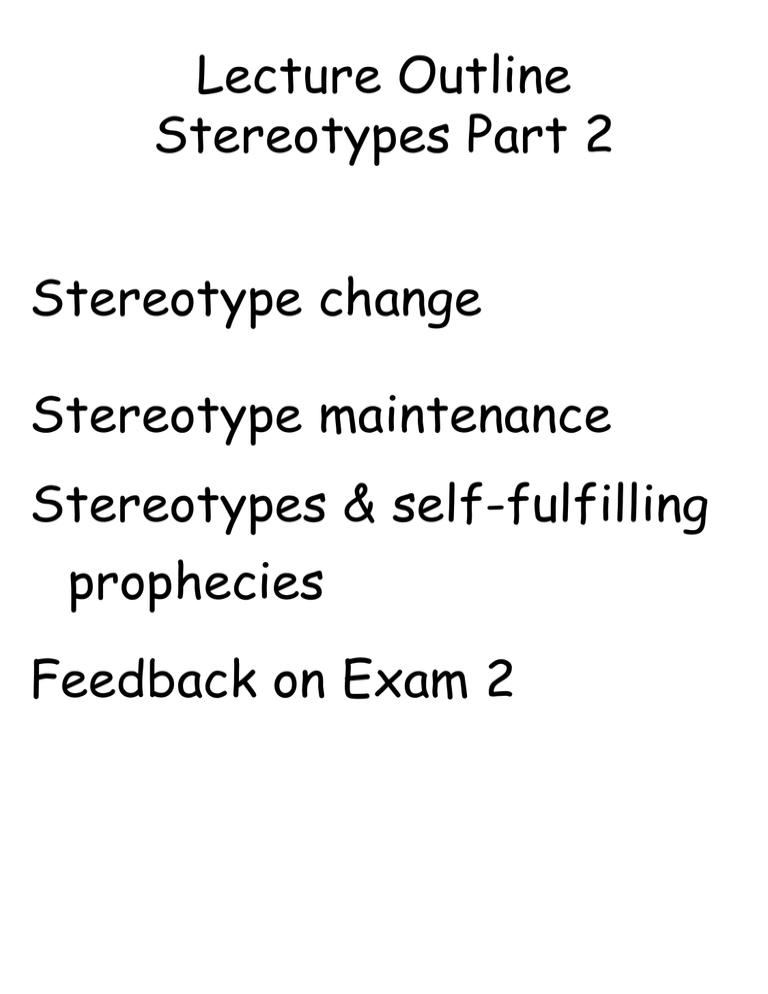
Lecture Outline Stereotypes Part 2 Stereotype change Stereotype maintenance Stereotypes & self-fulfilling prophecies Feedback on Exam 2 Models of Stereotype Change Bookkeeping Model Conversion Model Subtyping Model Bookkeeping Model Each instance of inconsistent information changes the stereotype Single instance = small change Accumulation = large change Bookkeeping Model Large numbers of inconsistent information change a stereotype Bookkeeping Model Prediction The greater the amount of inconsistent information, the more a stereotype changes Conversion Model Highly salient instances of inconsistent information change a stereotype Conversion Model Prediction Inconsistent information that is concentrated in a few individuals leads to more stereotype change Subtyping Model Typical instances of inconsistent information change a stereotype Rare instances of inconsistent information lead to subtypes Subtyping Model Prediction Inconsistent information that is dispersed across many individuals leads to more stereotype change Stereotype Change Study Weber & Crocker (1983) Purpose: Tested the three models of stereotype change Procedure: Given information about lawyers Rated each lawyer on stereotypic traits Stereotype Change Study Weber & Crocker (1983) Manipulations Amount: Small: 6 inconsistent traits Large: 30 inconsistent traits Pattern: Dispersed Concentrated Stereotype Change Study Weber & Crocker (1983) Predictions More stereotype change when inconsistent information is: large (bookkeeping) concentrated (conversion) dispersed (subtyping) Stereotype Change Study Weber & Crocker (1983) Stereotype Change 8 7 6 5 4 3 Small Large Amount Stereotype Change Study Weber & Crocker (1983) Stereotype Change 8 7 6 5 4 3 Dispersed Concentrated Pattern Stereotype Maintenance Subtyping Model Subtypes maintain stereotypes Cognitive Biases Better recall of stereotype-consistent information Confirmation bias Recall Study Cohen (1981) Procedures Video (librarian vs. waitress) Attributes did and did not match the stereotype Recalled target’s attributes Recall Study % recalled correctly Cohen (1981) 90% 85% 80% 75% 70% 65% 60% Consistent Information Inconsistent Information Confirmation Biases in Hypothesis Testing Search for information that confirms one’s beliefs Introverted-Extroverted Studies Snyder & Colleagues Introverted: “What factors make it hard for you to really open up to people?” Extroverted: “What kind of situations do you seek out if you want to meet new people?” Introverted-Extroverted Studies Snyder & Colleagues Results Participants asked questions that that elicited confirming behavior from partner Why Study Stereotypes? Stereotypes may create social problems One way they can do this is through self-fulfilling prophecies Self-Fulfilling Prophecies Definition: Self-fulfilling prophecies are false beliefs that lead to their own fulfillment Three steps to a SFP 1. Perceiver holds false belief about target 2. Perceiver treats target in manner consistent with false belief 3. Target responds to this treatment in such a way as to confirm the originally false belief Self-Fulfilling Prophecies are not Perceptual Biases Perceptual biases: When a perceiver believes that a false belief has come true, when in fact it has not Self-Fulfilling Prophecies Do Not Reflect Predictive Accuracy Predictive Accuracy: When a perceiver correctly predicts a target’s future behavior, but did not cause that behavior to occur (I predict Jazz will win, and they do) Attractiveness Study Snyder, Tanke, & Bersheid (1978) Purpose: Examine whether the attractiveness stereotype is self-fulfilling Stereotype is that attractive people have all sorts of good attributes (e.g., intelligent, friendly, sociable) Attractiveness Study Snyder et al. (1978) Participants: 51 men and 51 women men and women paired off never saw one another Men = perceivers Women = targets Attractiveness Study Snyder et al., (1978) Procedure: Interactions w/o nonverbal behavior Biographical questionnaire for partner Photo of male Male got photo of his female partner Male rated his partner on traits Conversed over telephone (tape made) Male rated his partner again Attractiveness Study Snyder et al., (1978) Manipulation: Attractive partner Unattractive partner Attractiveness Study Snyder et al., (1978) Judges listened to conversation Judges rated male’s behavior Judges rated female’s behavior Attractiveness Study Snyder et al., (1978) Results: Males judged warmer and nicer in attractive condition Females judged warmer and friendlier in attractive condition Attractiveness Study Snyder et al., (1978) Only possible cause of differences in behavior after conversation was due to the treatment they received…………... Attractiveness Study Snyder et al., (1978) Specifically……. The men were very warm and nice to the “beautiful” women The “beautiful” women responded in kind. Attractiveness Study Snyder et al., (1978) The men were not warm and not nice to the “unattractive” women The “unattractive” women responded in kind. Accumulation of Self-Fulfilling Prophecies Accumulation occurs when... Two or more perceivers hold the same inaccurate stereotype about the same target. The perceivers each have a selffulfilling effect on the target’s behavior. The target confirms the stereotype more than s/he would have had only one perceiver held the inaccurate stereotype. Overweight Study (Madon et al., 2011) Stereotype: Overweight people lack willpower and self-control. Participants (N = 723) assigned to one of three expectation groups. Each group (N = 241) had 3 participants: 2 designated as perceivers 1 designated as the target Overweight Study (Madon et al., 2011) Groups were randomly assigned to one of three expectation conditions: Expectation Conditions Double Overweight Expectation (n = 82) Both perceivers believed target was overweight. Single overweight expectation (n = 76) No overweight Expectation (n = 82) One perceiver believed target was overweight, other did not. Neither perceiver believed target was overweight. Expectation of target’s weight induced via a photo Overweight Study (Madon et al., 2011) Perceivers completed a questionnaire that assessed: 1. Whether they stereotyped the target. Self-control & Willpower (stereotypic) Religious & Intelligent (irrelevant to stereotype) 2. Whether they treated the target differently depending on her weight. Overweight Study (Madon et al., 2011) 1. Participants given a bowl of candy. 2. Amount of candy in bowl equaled the total amount selected by the two perceivers in the target’s group. 3. Experimenter recorded how much candy each target took Overweight Study (Madon et al., 2011) Were perceivers’ expectations for the target based on the overweight stereotype? YES Not overweight Over weight Perceivers’ Judgments of Targets’ Personality 5.00 4.00 3.00 2.00 Willpower Self-control Intelligent Religious Overweight Study (Madon et al., 2011) Did perceivers’ stereotypic expectations have cumulative SFPs on target’s behavior? Amount of Candy Targets Took 6.00 YES 5.00 4.00 3.00 2.00 1.00 0.00 No Overweight Expectation Single Overweight Expectation Double Overweight Expectation Expectation Conditions


